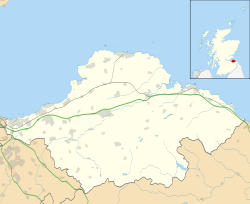Dunglass Castle was built by the Pepdies of Dunglass in the 14th century. On the marriage of Nicola Pepdie to Sir Thomas Home of Home, the castle and lands passed to the Home family. James IV of Scotland stayed in December 1496, and played cards. He gave a tip to masons working on the building and enjoyed a banquet including spices bought from Edinburgh. [2]
Rough Wooing
In 1547, during the war now known as the Rough Wooing, Dunglass was captured by the forces of the Duke of Somerset from George Douglas of Pittendreich, and was fortified and garrisoned by the English. A new artillery fortification was built overlooking the old castle of the Home family. [3] [4] In January 1549 the French landed two boat loads of ladders at Dunbar, intending to assault the fort. [5]
The English soldiers were entertained by two Irish minstrels on 9 July 1549. [6] On 31 January 1550 English soldiers raided Keith Marischal, burning two barn yards at the Place of Nether Keith and houses in the village. They were chased back to Dunglas. Regent Arran gave orders for cannon to be shipped to re-take the fort on 11 April 1550. [7] The Earl of Rutland was at Dunglass in May 1550 and took the opportunity to have his mail armour scoured in a bag of bran and had his pistol mended. He bought white fabric in the camp at Dunglass to modify his hose for the hot weather in July. [8]
The fort at Dunglass was surrendered to the French in March 1550. [9] In June, the remaining cannon were taken to Dunbar Castle and the villagers in the area were summoned to slight the fort. [10]
Earls of Home and the Hall family
In October 1595 Christian Douglas, Lady Home moved her best household goods from Dunglass to Fife, sparking rumours of a marital separation. [11] James VI of Scotland stayed with her husband Lord Home at Dunglass Castle on 13 March 1596, for his "sports". [12] He alarmed the English garrison by coming to hunt near Berwick-upon-Tweed, staying a night the house of the laird of 'Beelleys' (Billie Castle), six miles from Berwick, and then returning to Dunglass. [13]
The castle was rebuilt, in an enlarged and improved form, and gave accommodation on 5 April 1603 to King James VI, and all his retinue, when on his journey to London to take up the English throne. [4] It was improved by Mary, Countess of Home and her husband, Alexander Home, 1st Earl of Home, who escorted King James from Berwick to Dunglass, and then to Pencraig by East Linton Bridge in 1617. [14]
The castle was destroyed again on 30 August 1640 when held by a party of Covenanters under Thomas, Earl of Haddington. An English page, according to Scotstarvet, vexed by a taunt against his countrymen, thrust a red-hot iron into a powder barrel, and himself was killed, with the Earl, his half-brother, Richard, and many others. [4] A pamphlet with a verse account of the explosion and a list of casualties was published by the author and poet William Lithgow. He named thirty nine dead including five women, and John White, an English plasterer working for Lady Home. [15]
The Hall family occupied Dunglass for 232 years from 1687. Francis James Usher bought the Estate from Sir John Richard Hall, 9th Bart in 1919, and the estate remains in the Usher family. [16] The Earl of Home continues to hold the title "Lord of Dunglass", despite the fact his family have not held Dunglass for several centuries.


